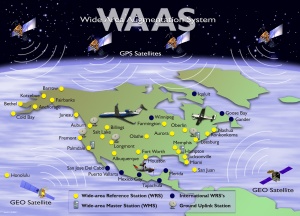If you wish to contribute or participate in the discussions about articles you are invited to contact the Editor
WAAS User Segment
| WAAS | |
|---|---|
| Title | WAAS User Segment |
| Author(s) | GMV. |
| Level | Basic |
| Year of Publication | 2011 |
The Wide Area Augmentation System (WAAS) is an GPS Augmentation system developed by the Federal Aviation Administration (FAA), with the goal of improving its accuracy, integrity, and availability. Essentially, WAAS is intended to enable aircraft to rely on GPS for all phases of flight, including precision approaches to any airport within its coverage area.
WAAS uses a network of ground-based reference stations, in North America and Hawaii, to measure small variations in the GPS satellites' signals in the western hemisphere. Measurements from the reference stations are routed to master stations, which queue the received Deviation Correction (DC) and send the correction messages to geostationary WAAS satellites in a timely manner (every 5 seconds or better). Those satellites broadcast the correction messages back to Earth, where WAAS-enabled GPS receivers use the corrections while computing their positions to improve accuracy.[1]
WAAS User Segment
WAAS User Segment: The user segment is the GPS and WAAS receiver, which uses the information broadcast from each GPS satellite to determine its location and the current time, and receives the WAAS corrections from the Space segment.
The two types of WAAS correction messages received (fast and slow) are used in different ways. The GPS receiver can immediately apply the fast type of correction data, which includes the corrected satellite position and clock data, and determines its current location using normal GPS calculations. Once an approximate position fix is obtained the receiver begins to use the slow corrections to improve its accuracy. Among the slow correction data is the ionospheric delay. As the GPS signal travels from the satellite to the receiver, it passes through the ionosphere. The receiver calculates the location where the signal pierced the ionosphere and, if it has received an ionospheric delay value for that location, corrects for the error the ionosphere created. While the slow data can be updated every minute if necessary, ephemeris errors and ionosphere errors do not change this frequently, so they are only updated every two minutes and are considered valid for up to six minutes.

